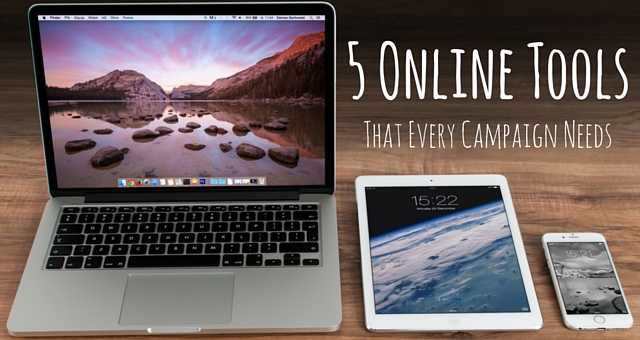Blog
5 Online Tools That Every Campaign Needs
January 28, 2016

Last year, the 2016 Republican presidential candidates held a debate at the Reagan Presidential Library. It is not shocking that over the course of the evening, Ronald Reagan’s name was mentioned 63 times. Both the venue and invoking of the late president shows that his spirit and principles are alive and well within conservative politics today.
While the Gipper’s influence lives on, it’s not the 80s anymore! With new technologies at our disposal, political strategy has shifted drastically to keep up with these new platforms. If conservatives are going to compete in today’s political landscape, we need to learn to leverage these technologies to our advantage.
Here are five tools that every campaign needs to maintain an effective online presence.
1. Campaign Website
Without a website, you can say goodbye to your campaign’s success! A website will serve as a place for you to publicly display your candidate’s bio, platform, campaign news, calls to action, donation opportunities, event signups, volunteer signups… you get the picture.
When I research candidates, you would be surprised by how many of them don’t even bother to create a website. That means that I have to take time to dig through other resources to find out what I need. While, as a political junkie, I will gladly take the time to do that, the average voter will not, and the candidate misses the opportunity to frame his own campaign identity. Point being: get a website.
For low budget campaigners, sites like WordPress and Blogger are great if you want a free site to get you started.
1.5 Campaign Blog
While your blog should exist inside your website, I have included it as a separate section to emphasize its importance. A blog gives you an incredible opportunity to create your own content and share it online. Content can range from news, opinion pieces, interviews, testimonials, short messages from the candidate, and much more.
Plus, creating a blog is easy. If you use WordPress or Blogger for your website, you can use the built-in blogging feature to get started right away.
2. Campaign Twitter Account
We talk a lot about the importance of Twitter for the conservative activist and campaign. A growing number of people use Twitter for news and seek out public figures to follow. It’s a valuable avenue to keep your voters and the media up-to-date with where you’re at with your campaign as well as an incredible opportunity to interact with voters one-on-one.
Consider hosting a Twitter chat, answering questions, posting polls, and engaging with the accounts of friends and supporters. As you brainstorm ways to produce consistent content, check out “37 Tweet Ideas for the Political Candidate.” Take advantage of free tools such as Buffer to schedule Tweets ahead of time and TweetDeck to analyze your account.
3. Campaign Email Marketing Platform
Are you collecting email addresses and building an email list? If not, you really should—it will pay off immensely when you begin your big volunteer recruitment and GOTV pushes. Despite the surge in social networks, email marketing is still king and will be one of the most valuable ways to connect with your voters and supporters.
There are several platforms that are very helpful, including MailChimp and Campaign Monitor. Typically, you can get an initial version for free, but then they will charge as you grow your email list. The great thing about these programs is that they allow you to embed a signup form into your website—and you don’t even have to know programming to do it! Then, you can send blasts out to all of your subscribers, or segment your blasts based on their interests and activity.
4. Campaign Facebook Page
For years, Facebook has ranked—and still ranks—as the #1 social media site worldwide. Facebook is also incredibly popular across generational lines—60% of Millennials and half of Gen-Xers get their news from the social media site—so it serves as a great venue to get your campaign’s name about there.
If someone searches for your name on Facebook, what will they find? Ensure that it’s your page, describing your campaign in your own words instead of someone else framing your campaign for you.
Creating a page is easy (and free), and as long as you have plenty of photos, great content (the blog will help with that!), and you keep the page updated, it will do wonders to help increase your name recognition. Plus, if you want to take the next step and have a few extra dollars to invest, you can use Facebook ads to reach new people and even recruit some volunteers. Make sure that the Facebook page is not a dead end. Like any social network that you use, point your audience back to the online hub of your campaign: your campaign website.
5. Campaign YouTube Channel
Whether it’s a campaign announcement video, advertisement, clips of your recent speeches and/or interviews, or just a one-on-one sit down where you answer your voters’ questions, video material resonates with voters. Not only does it make the candidate look more like a person than a face, it allows the candidate to share his message with voters in a concise but engaging way. YouTube is the best place to publish this content.
There are plenty of other tools you can use—Twitter, Instagram, Pinterest, LinkedIn, etc.—but these five will provide you with a solid online foundation. If you can leverage these well, you can bring your campaign into the 21st century and win over voters of every generation.
Need more help kick-starting your online activity? Check out our online resources for more tips on how to best leverage online marketing for your campaign!
